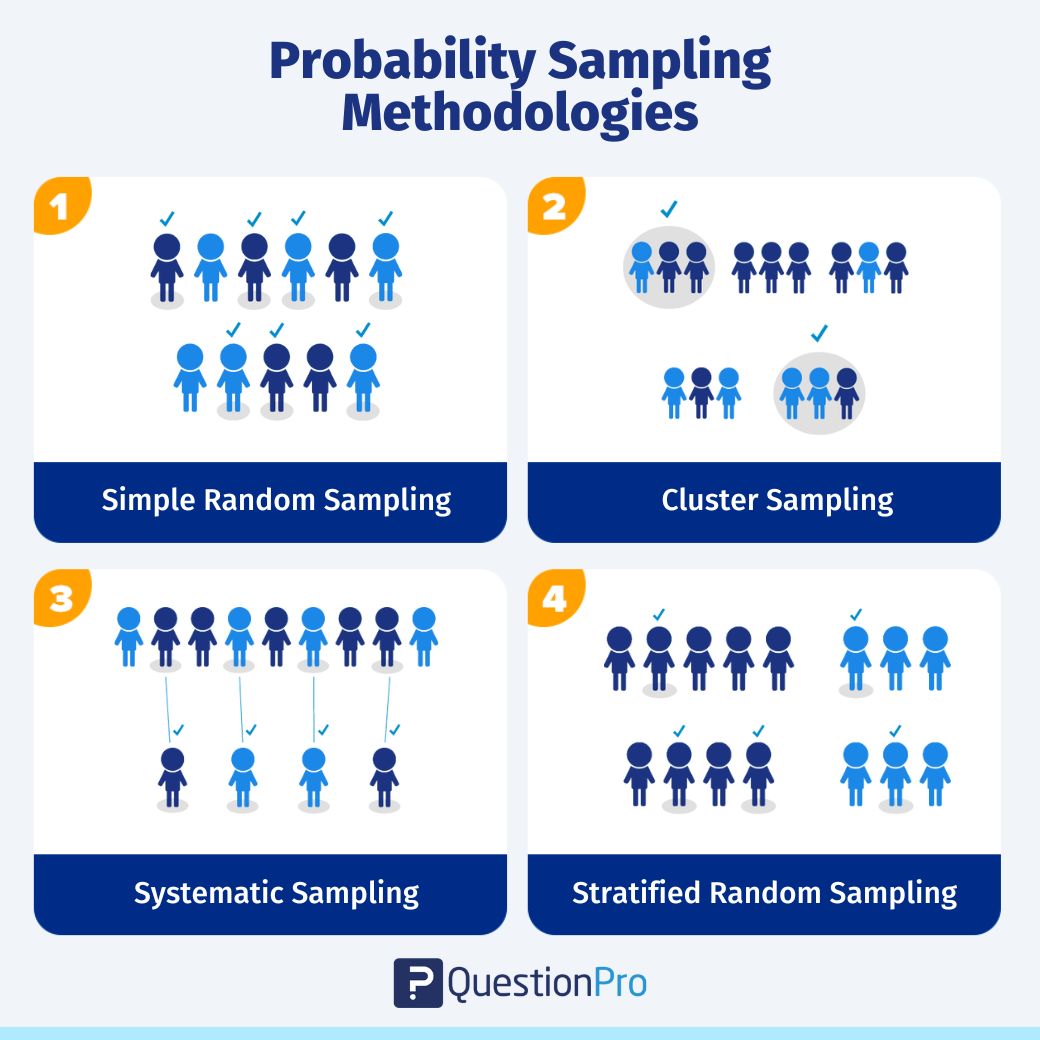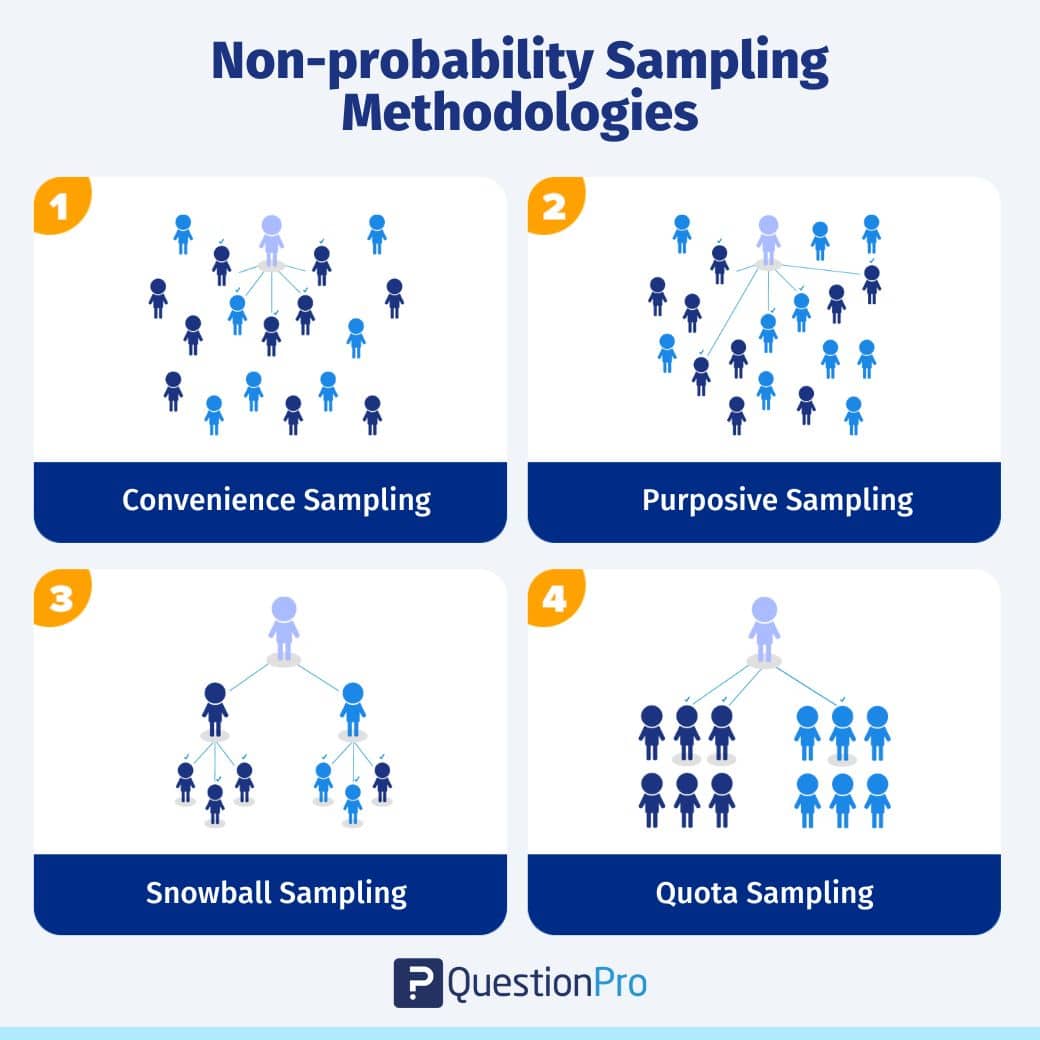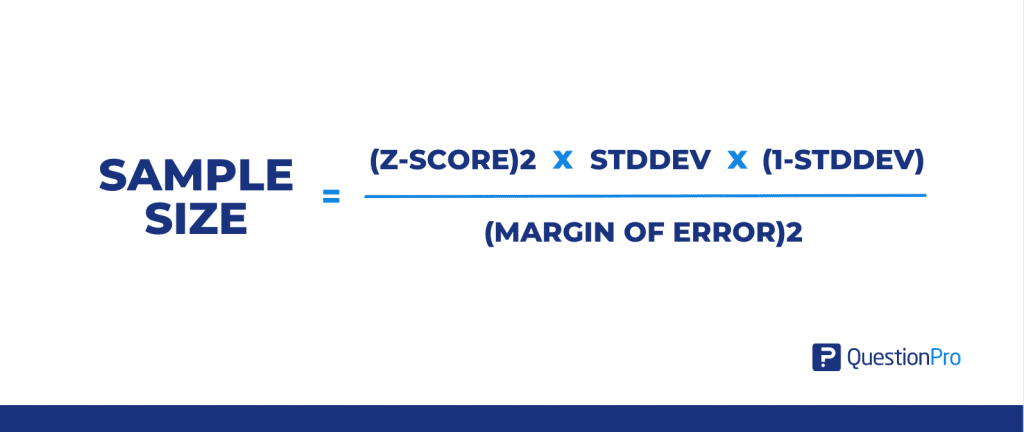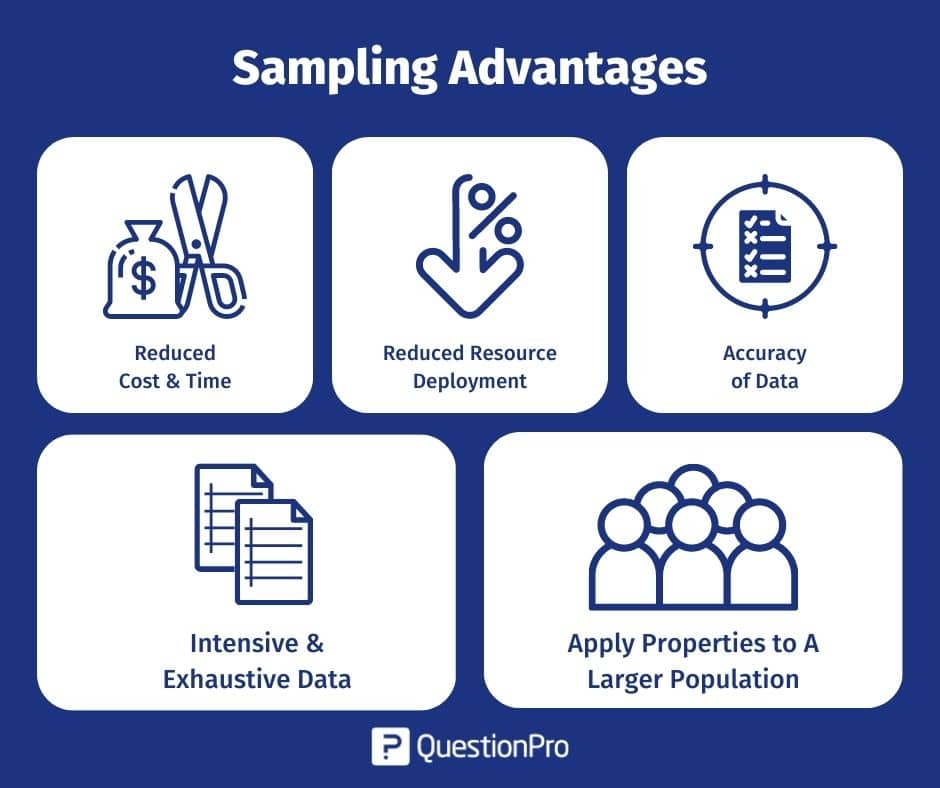
นักวิจัยมองหาผู้ตอบแบบสํารวจที่เหมาะสมบ่อยแค่ไหน ไม่ว่าจะเป็นการศึกษาวิจัยตลาดหรือแบบสํารวจที่มีอยู่ในภาคสนาม กลุ่มตัวอย่างหรือผู้ตอบแบบสอบถามของการวิจัยนี้อาจถูกเลือกจากกลุ่มลูกค้าหรือผู้ใช้ที่รู้จักหรือไม่รู้จัก
คุณอาจทราบโปรไฟล์ผู้ตอบแบบสอบถามทั่วไปของคุณบ่อยครั้ง แต่ไม่สามารถเข้าถึงผู้ตอบแบบสอบถามเพื่อทําการศึกษาวิจัยของคุณให้เสร็จสมบูรณ์ ในช่วงเวลาดังกล่าวนักวิจัยและทีมวิจัยจะติดต่อองค์กรเฉพาะทางเพื่อเข้าถึงกลุ่มผู้ตอบแบบสอบถามหรือซื้อผู้ตอบแบบสอบถามจากพวกเขาเพื่อทําการศึกษาวิจัยและแบบสํารวจให้เสร็จสมบูรณ์
เหล่านี้อาจเป็นผู้ตอบแบบสอบถามประชากรทั่วไปที่ตรงกับเกณฑ์ประชากรศาสตร์หรือผู้ตอบแบบสอบถามตามเกณฑ์เฉพาะ ผู้ตอบแบบสอบถามดังกล่าวมีความจําเป็นต่อความสําเร็จของการศึกษาวิจัย
บทความนี้กล่าวถึงรายละเอียดเกี่ยวกับตัวอย่างประเภทต่างๆ วิธีการสุ่มตัวอย่าง และตัวอย่างของแต่ละประเภท นอกจากนี้ยังกล่าวถึงขั้นตอนในการคํานวณขนาด รายละเอียดของตัวอย่างออนไลน์ และข้อดีของการใช้งาน
ดัชนีเนื้อหา
- ตัวอย่างคืออะไร?
- ประเภทของตัวอย่าง: วิธีการเลือกตัวอย่างพร้อมตัวอย่าง
- วิธีกําหนดขนาดตัวอย่าง
- การคํานวณขนาดตัวอย่าง
- ข้อดีของการสุ่มตัวอย่าง
ตัวอย่างคืออะไร?
ตัวอย่างคือชุดข้อมูลที่เล็กกว่าที่นักวิจัยเลือกหรือเลือกจากประชากรจํานวนมากโดยใช้วิธีการ อคติการเลือก ที่กําหนดไว้ล่วงหน้า องค์ประกอบเหล่านี้เรียกว่าจุดตัวอย่างหน่วยสุ่มตัวอย่างหรือการสังเกต
การสร้างตัวอย่างเป็นวิธีที่มีประสิทธิภาพในการวิจัย . การค้นคว้าเกี่ยวกับประชากรทั้งหมดมักเป็นไปไม่ได้มีค่าใช้จ่ายสูงและใช้เวลานาน ดังนั้นการตรวจสอบตัวอย่างจึงให้ข้อมูลเชิงลึกที่นักวิจัยสามารถนําไปใช้กับประชากรทั้งหมดได้
ตัวอย่างเช่น หากผู้ผลิตโทรศัพท์มือถือต้องการดําเนินการศึกษาวิจัยคุณลักษณะในหมู่นักศึกษาในมหาวิทยาลัยในสหรัฐอเมริกา ต้องทําการศึกษาวิจัยเชิงลึกหากผู้วิจัยกําลังมองหาคุณสมบัติที่นักเรียนใช้ คุณลักษณะที่พวกเขาต้องการเห็น และราคาที่พวกเขายินดีจ่าย
ขั้นตอนนี้จําเป็นอย่างยิ่งที่จะต้องทําความเข้าใจคุณสมบัติที่ต้องพัฒนาคุณสมบัติที่ต้องอัปเกรดราคาของอุปกรณ์และกลยุทธ์การเข้าสู่ตลาด
ในปี 2016/17 เพียงปีเดียว มีนักศึกษา 24.7 ล้านคนลงทะเบียนเรียนในมหาวิทยาลัยทั่วสหรัฐอเมริกา เป็นไปไม่ได้ที่จะค้นคว้านักเรียนเหล่านี้ทั้งหมด เวลาที่ใช้จะทําให้อุปกรณ์ใหม่ซ้ําซ้อน และเงินที่ใช้ในการพัฒนาจะทําให้การศึกษาไร้ประโยชน์
การสร้างตัวอย่างของมหาวิทยาลัยตามที่ตั้งทางภูมิศาสตร์และการสร้างตัวอย่างของนักศึกษาเหล่านี้จากมหาวิทยาลัยเหล่านี้ทําให้มีนักศึกษาจํานวนมากเพียงพอสําหรับการวิจัย
โดยปกติแล้วประชากรสําหรับการวิจัยตลาด มีมหึมามาก การแจงนับประชากรทั้งหมดเป็นไปไม่ได้ในทางปฏิบัติ ตัวอย่างมักจะแสดงถึงขนาดที่จัดการได้ของประชากรนี้ จากนั้นนักวิจัยจะรวบรวมข้อมูลจากตัวอย่างเหล่านี้ผ่านการสํารวจ โพล และแบบสอบถาม และคาดการณ์การวิเคราะห์ข้อมูลนี้ไปยังชุมชนในวงกว้าง
เรียนรู้เกี่ยวกับ: การสุ่มตัวอย่างแบบสํารวจ
ประเภทของตัวอย่าง: วิธีการคัดเลือกพร้อมตัวอย่าง
กระบวนการรับตัวอย่างเรียกว่าวิธีการสุ่มตัวอย่าง การสุ่มตัวอย่างเป็นส่วนสําคัญของ การออกแบบการวิจัย เนื่องจากวิธีนี้ได้รับข้อมูลเชิงปริมาณและเชิงคุณภาพที่สามารถรวบรวมเป็นส่วนหนึ่งของการศึกษาวิจัย วิธีการสุ่มตัวอย่าง มีลักษณะเฉพาะเป็นสองวิธีที่แตกต่างกัน: การสุ่มตัวอย่างความน่าจะเป็นและการสุ่มตัวอย่างแบบไม่น่าจะเป็น
วิธีการสุ่มตัวอย่างความน่าจะเป็นพร้อมตัวอย่าง
การสุ่มตัวอย่างความน่าจะเป็น เป็นวิธีการได้มาของตัวอย่างที่วัตถุถูกเลือกจากประชากรตามทฤษฎีความน่าจะเป็น วิธีนี้รวมถึงทุกคนในประชากร และทุกคนมีโอกาสเท่าเทียมกันในการได้รับเลือก ดังนั้นจึงไม่มีอคติใด ๆ ในตัวอย่างประเภทนี้
แต่ละคนในประชากรสามารถเป็นส่วนหนึ่งของการวิจัยได้ในภายหลัง เกณฑ์การคัดเลือกจะถูกตัดสินตั้งแต่เริ่มต้นของการศึกษาวิจัยตลาดและเป็นองค์ประกอบสําคัญของการวิจัย
เรียนรู้เกี่ยวกับ: การวิจัยเชิงปฏิบัติการ

การสุ่มตัวอย่างความน่าจะเป็นสามารถจําแนกเพิ่มเติมได้เป็นสี่ประเภทของตัวอย่างที่แตกต่างกัน พวกเขาคือ:
- การสุ่มตัวอย่างอย่างง่าย: วิธีที่ตรงไปตรงมาที่สุดในการเลือกตัวอย่างคือการสุ่มตัวอย่างอย่างง่าย. ในวิธีนี้สมาชิกแต่ละคนมีโอกาสเท่าเทียมกันในการเข้าร่วมการศึกษา วัตถุในประชากรตัวอย่างนี้ถูกเลือกแบบสุ่ม และสมาชิกแต่ละคนมีความน่าจะเป็นเท่ากันที่จะถูกเลือก ตัวอย่างเช่นหากคณบดีมหาวิทยาลัยต้องการรวบรวมข้อเสนอแนะจากนักศึกษาเกี่ยวกับการรับรู้เกี่ยวกับครูและระดับการศึกษานักศึกษาทั้ง 1,000 คนในมหาวิทยาลัยอาจเป็นส่วนหนึ่งของกลุ่มตัวอย่างนี้ สามารถสุ่มเลือกนักเรียน 100 คนเพื่อเป็นส่วนหนึ่งของตัวอย่างนี้ได้
- การสุ่มตัวอย่างคลัสเตอร์: การสุ่มตัวอย่างคลัสเตอร์ เป็นวิธีการสุ่มตัวอย่างประเภทหนึ่งที่ประชากรผู้ตอบแบบสอบถามแบ่งออกเป็นคลัสเตอร์เท่าๆ กัน คลัสเตอร์ถูกระบุและรวมอยู่ในกลุ่มตัวอย่างตามการกําหนดพารามิเตอร์ทางประชากร เช่น อายุ สถานที่ เพศ ฯลฯ สิ่งนี้ทําให้ผู้สร้างแบบสํารวจสามารถอนุมานในทางปฏิบัติจากข้อเสนอแนะได้ง่ายมาก ตัวอย่างเช่นหากองค์การอาหารและยาต้องการรวบรวมข้อมูลเกี่ยวกับผลข้างเคียงที่ไม่พึงประสงค์จากยาพวกเขาสามารถแบ่งแผ่นดินใหญ่ของสหรัฐอเมริกาออกเป็นที่โดดเด่น การวิเคราะห์คลัสเตอร์เหมือนรัฐ การศึกษาวิจัยจะถูกนําไปใช้กับผู้ตอบแบบสอบถามในคลัสเตอร์เหล่านี้ การสร้างตัวอย่างประเภทนี้ทําให้การรวบรวมข้อมูลในเชิงลึกและให้ข้อมูลเชิงลึกที่ง่ายต่อการบริโภคและดําเนินการตาม
- การสุ่มตัวอย่างอย่างเป็นระบบ: การสุ่มตัวอย่างอย่างเป็นระบบ เป็นวิธีการสุ่มตัวอย่างที่นักวิจัยเลือกผู้ตอบแบบสอบถามในช่วงเวลาที่เท่ากันจากประชากร แนวทางในการเลือกกลุ่มตัวอย่างคือการเลือกจุดเริ่มต้นแล้วเลือกผู้ตอบแบบสอบถามตามช่วงเวลาตัวอย่างที่กําหนดไว้ล่วงหน้า ตัวอย่างเช่น ในขณะที่เลือกอาสาสมัคร 1,000 คนสําหรับการแข่งขันกีฬาโอลิมปิกจากรายชื่อผู้สมัคร 10,000 คน ผู้สมัครแต่ละคนจะได้รับจํานวน 1 ถึง 10,000 คน จากนั้นเริ่มจาก 1 และเลือกผู้ตอบแบบสอบถามแต่ละคนด้วยช่วงเวลา 10 สามารถรับตัวอย่างอาสาสมัคร 1,000 คน
- การสุ่มตัวอย่างแบบแบ่งชั้น: การสุ่มตัวอย่างแบบแบ่งชั้น เป็นวิธีการแบ่งประชากรผู้ตอบแบบสอบถามออกเป็นพารามิเตอร์ที่โดดเด่นแต่กําหนดไว้ล่วงหน้าในขั้นตอนการออกแบบการวิจัย ในวิธีนี้ผู้ตอบแบบสอบถามจะไม่ทับซ้อนกัน แต่รวมกันเป็นตัวแทนของประชากรทั้งหมด ตัวอย่างเช่น นักวิจัยที่ต้องการวิเคราะห์ผู้คนจากภูมิหลังทางเศรษฐกิจและสังคมที่แตกต่างกันสามารถแยกแยะผู้ตอบแบบสอบถามด้วยเงินเดือนประจําปีของพวกเขา สิ่งนี้จะสร้างกลุ่มคนหรือตัวอย่างที่เล็กลง จากนั้นวัตถุบางอย่างจากตัวอย่างเหล่านี้สามารถใช้สําหรับการศึกษาวิจัยได้
เรียนรู้เกี่ยวกับ: การ สุ่มตัวอย่างแบบมีวัตถุประสงค์
วิธีการสุ่มตัวอย่างที่ไม่น่าจะเป็นพร้อมตัวอย่าง
การสุ่มตัวอย่างแบบไม่น่าจะเป็น วิธีการใช้ดุลยพินิจของผู้วิจัยในการเลือกตัวอย่าง ตัวอย่างประเภทนี้ส่วนใหญ่มาจากความสามารถของนักวิจัยหรือนักสถิติในการเข้าถึงตัวอย่างนี้
การสุ่มตัวอย่างประเภทนี้ใช้สําหรับการวิจัยเบื้องต้นซึ่งมีวัตถุประสงค์หลักเพื่อให้ได้มาซึ่งสมมติฐานเกี่ยวกับหัวข้อในการวิจัย ที่นี่สมาชิกแต่ละคนไม่มีโอกาสเท่ากันที่จะเป็นส่วนหนึ่งของประชากรกลุ่มตัวอย่าง และพารามิเตอร์เหล่านั้นจะทราบเฉพาะหลังการคัดเลือกของกลุ่มตัวอย่างเท่านั้น

เราสามารถจําแนกการสุ่มตัวอย่างที่ไม่น่าจะเป็นออกเป็นสี่ประเภทของตัวอย่างที่แตกต่างกัน พวกเขาคือ:
- การสุ่มตัวอย่างที่สะดวก: การสุ่มตัวอย่างที่สะดวกพูดง่ายๆ ก็หมายถึงความสะดวกของนักวิจัยในการเข้าถึงผู้ตอบแบบสอบถาม ไม่มีวิธีการทางวิทยาศาสตร์ในการรับตัวอย่างนี้ นักวิจัยแทบไม่มีอํานาจในการเลือกองค์ประกอบตัวอย่าง และทําได้โดยพิจารณาจากความใกล้ชิดและไม่ใช่การเป็นตัวแทน
วิธีการสุ่มตัวอย่างแบบไม่น่าจะเป็นนี้ใช้เมื่อมีข้อจํากัดด้านเวลาและค่าใช้จ่ายในการรวบรวมข้อเสนอแนะ ตัวอย่างเช่น นักวิจัยที่กําลังทําแบบสํารวจการสกัดกั้นห้างสรรพสินค้าเพื่อทําความเข้าใจความน่าจะเป็นของการใช้น้ําหอมจากผู้ผลิตน้ําหอม ในวิธีการสุ่มตัวอย่างนี้ ผู้ตอบแบบสอบถามกลุ่มตัวอย่างจะถูกเลือกโดยพิจารณาจากความใกล้ชิดกับโต๊ะสํารวจและความเต็มใจที่จะมีส่วนร่วมในการวิจัย
- การสุ่มตัวอย่างแบบตัดสิน/โดยเจตนา: การสุ่มตัวอย่างแบบตัดสินหรือแบบมีจุดประสงค์ วิธีการเป็นวิธีการพัฒนาตัวอย่างบนพื้นฐานและดุลยพินิจของผู้วิจัยอย่างแท้จริง โดยพิจารณาจากลักษณะของการศึกษาพร้อมกับความเข้าใจของเขา/เธอเกี่ยวกับกลุ่มเป้าหมาย วิธีการสุ่มตัวอย่างนี้เลือกเฉพาะผู้ที่ตรงกับเกณฑ์การวิจัยและวัตถุประสงค์สุดท้าย และส่วนที่เหลือจะถูกเก็บไว้
ตัวอย่างเช่นหากหัวข้อการวิจัยคือการทําความเข้าใจว่านักศึกษาต้องการมหาวิทยาลัยใดสําหรับปริญญาโทหากคําถามที่ถามคือ “คุณต้องการเรียนปริญญาโทหรือไม่” สิ่งอื่นใดนอกเหนือจากคําตอบ “ใช่” สําหรับคําถามนี้คนอื่น ๆ จะถูกแยกออกจากการศึกษานี้
- การสุ่มตัวอย่าง Snowball: การสุ่มตัวอย่าง Snowball หรือการสุ่มตัวอย่างแบบอ้างอิงแบบลูกโซ่ถูกกําหนดให้เป็นเทคนิคการสุ่มตัวอย่างที่ไม่น่าจะเป็นซึ่งตัวอย่างมีลักษณะที่หายาก นี่คือเทคนิคการสุ่มตัวอย่างที่อาสาสมัครที่มีอยู่ให้การอ้างอิงเพื่อรับสมัครตัวอย่างที่จําเป็นสําหรับการศึกษาวิจัย
ตัวอย่างเช่น ในขณะที่รวบรวมข้อเสนอแนะเกี่ยวกับหัวข้อที่ละเอียดอ่อน เช่น โรคเอดส์ ผู้ตอบแบบสอบถามจะไม่ให้ข้อมูล ในกรณีนี้ ผู้วิจัยสามารถรับสมัครผู้ที่มีความเข้าใจหรือความรู้เกี่ยวกับบุคคลดังกล่าว และรวบรวมข้อมูลจากพวกเขาหรือขอให้พวกเขารวบรวมข้อมูล
- การสุ่มตัวอย่างโควต้า: การสุ่มตัวอย่างโควต้า เป็นวิธีการรวบรวมตัวอย่างที่ผู้วิจัยมีอิสระในการเลือกตัวอย่างตามชั้นของตน ลักษณะสําคัญของวิธีนี้คือคนสองคนไม่สามารถดํารงอยู่ได้ภายใต้เงื่อนไขที่แตกต่างกันสองประการ ตัวอย่างเช่น เมื่อผู้ผลิตรองเท้าต้องการทําความเข้าใจการรับรู้ของคนรุ่นมิลเลนเนียลที่มีต่อแบรนด์ด้วยพารามิเตอร์อื่นๆ เช่น ความสะดวกสบาย ราคา ฯลฯ โดยเลือกเฉพาะผู้หญิงที่เป็นคนรุ่นมิลเลนเนียลสําหรับการศึกษานี้ เนื่องจากวัตถุประสงค์การวิจัยคือการรวบรวมข้อเสนอแนะเกี่ยวกับรองเท้าผู้หญิง
วิธีกําหนดขนาดตัวอย่าง
ดังที่เราได้เรียนรู้ไปข้างต้นการกําหนด ขนาดตัวอย่าง ที่เหมาะสมเป็นสิ่งสําคัญสําหรับความสําเร็จของการรวบรวมข้อมูลในการศึกษาวิจัยตลาด แต่มีตัวเลขที่ถูกต้องสําหรับขนาดตัวอย่างหรือไม่? พารามิเตอร์ใดที่กําหนดขนาดตัวอย่าง วิธีการแจกจ่ายแบบสํารวจมีอะไรบ้าง?
เพื่อให้เข้าใจทั้งหมดนี้และทําการคํานวณขนาดตัวอย่างที่เหมาะสมอย่างมีข้อมูลก่อนอื่นสิ่งสําคัญคือต้องเข้าใจตัวแปรสําคัญสี่ตัวที่ก่อให้เกิดลักษณะพื้นฐานของตัวอย่าง พวกเขาคือ:
- ขนาดประชากร: ขนาดประชากรคือทุกคนที่สามารถพิจารณาสําหรับการศึกษาวิจัยได้ จํานวนนี้ในกรณีส่วนใหญ่จะวิ่งเป็นจํานวนมาก ตัวอย่างเช่น ประชากรของสหรัฐอเมริกาอยู่ที่ 327 ล้านคน แต่ในการวิจัยตลาดเป็นไปไม่ได้ที่จะพิจารณาทั้งหมดสําหรับการศึกษาวิจัย
- ขอบของข้อผิดพลาด (ช่วงความเชื่อมั่น): ขอบของข้อผิดพลาดแสดงโดยเปอร์เซ็นต์ที่เป็นการอนุมานทางสถิติเกี่ยวกับความเชื่อมั่นของจํานวนประชากรที่แสดงถึงมุมมองที่แท้จริงของประชากรทั้งหมด เปอร์เซ็นต์นี้ช่วยใน การวิเคราะห์ทางสถิติ ในการเลือกตัวอย่างและข้อผิดพลาด ในการสุ่มตัวอย่าง ที่ยอมรับได้
เรียนรู้เกี่ยวกับ: ขั้นตอนกระบวนการวิจัย
- ระดับความเชื่อมั่น: เมตริกนี้วัดว่าค่าเฉลี่ยจริงอยู่ในช่วงความเชื่อมั่นที่ใด ช่วงความเชื่อมั่นที่พบบ่อยที่สุดคือ 90%, 95% และ 99%
- ส่วนเบี่ยงเบนมาตรฐาน: เมตริกนี้ครอบคลุมความแปรปรวนในแบบสํารวจ ตัวเลขที่ปลอดภัยที่ต้องพิจารณาคือ .5 ซึ่งหมายความว่าขนาดตัวอย่างจะต้องใหญ่ขนาดนั้น
การคํานวณขนาดตัวอย่าง
ในการคํานวณขนาดตัวอย่างคุณต้องมีพารามิเตอร์ต่อไปนี้
- คะแนน Z: ค่าคะแนน Z สามารถพบได้ที่นี่
- ส่วนเบี่ยงเบนมาตรฐาน
- ขอบของข้อผิดพลาด
- ระดับความเชื่อมั่น
ในการคํานวณโดยใช้ขนาดตัวอย่าง ให้ใช้สูตรนี้:

ขนาดตัวอย่าง = (Z-score)2 * StdDev*(1-StdDev) / (ขอบของข้อผิดพลาด)2
พิจารณาระดับความเชื่อมั่น 90% ค่าเบี่ยงเบนมาตรฐานของ .6 และขอบของข้อผิดพลาด +/-4%
((1.64)2 x .6(.6)) / (.04)2
( 2.68x .0.36) / .0016
.9648 / .0016
603
จําเป็นต้องมีผู้ตอบแบบสอบถาม 603 คน และนั่นจะกลายเป็นขนาดตัวอย่างของคุณ
ลองใช้เครื่องคํานวณขนาดตัวอย่างของเราเพื่อให้จํานวนประชากร เครื่องคํานวณขอบข้อผิดพลาด และระดับความเชื่อมั่น
เรียนรู้เพิ่มเติม: ประชากรเทียบกับตัวอย่าง
ข้อดีของการสุ่มตัวอย่าง
ดังที่แสดงไว้ข้างต้น การสุ่มตัวอย่างมีข้อดีหลายประการ ข้อดีที่สําคัญที่สุดบางประการคือ:

- ลดต้นทุนและเวลา: เนื่องจากการใช้ตัวอย่างช่วยลดจํานวนคนที่ต้องติดต่อ จึงช่วยลดต้นทุนและเวลา ลองนึกภาพเวลาที่ประหยัดได้ระหว่างการค้นคว้ากับประชากรหลายล้านคนเทียบกับการศึกษาวิจัยโดยใช้ตัวอย่าง
- การปรับใช้ทรัพยากรที่ลดลง: เห็นได้ชัดว่าหากจํานวนผู้ที่เกี่ยวข้องในการศึกษาวิจัยลดลงมากเนื่องจากกลุ่มตัวอย่างทรัพยากรที่ต้องการก็น้อยลงเช่นกัน แรงงานที่จําเป็นในการวิจัยกลุ่มตัวอย่างนั้นน้อยกว่าแรงงานที่จําเป็นใน การศึกษาประชากรทั้งหมดมาก
- ความถูกต้องของข้อมูล: เนื่องจากตัวอย่างระบุประชากรข้อมูลที่รวบรวมจึงถูกต้อง นอกจากนี้ เนื่องจากผู้ตอบเต็มใจที่จะเข้าร่วม อัตราการออกกลางคันของแบบสํารวจ นั้นต่ํากว่ามาก ซึ่งจะเพิ่มความถูกต้องและความถูกต้องของข้อมูล
- ข้อมูลที่เข้มข้นและครบถ้วนสมบูรณ์: เนื่องจากมีผู้ตอบแบบสอบถามน้อยกว่าข้อมูลที่รวบรวมจากกลุ่มตัวอย่างจึงเข้มข้นและละเอียดถี่ถ้วน ผู้ตอบแบบสอบถามแต่ละคนให้เวลาและความพยายามมากขึ้นแทนที่จะรวบรวมข้อมูลจากผู้คนจํานวนมาก
- ใช้คุณสมบัติกับประชากรที่ใหญ่ขึ้น: เนื่องจากตัวอย่างบ่งบอกถึงประชากรที่กว้างขึ้น จึงปลอดภัยที่จะบอกว่าข้อมูลที่รวบรวมและวิเคราะห์จากกลุ่มตัวอย่างสามารถนําไปใช้กับประชากรที่ใหญ่ขึ้นได้ ซึ่งจะถือเป็นจริง
เพื่อรวบรวมข้อมูลที่ถูกต้องสําหรับการวิจัยกรองผู้อภิปรายที่ไม่ดี และขจัดอคติในการสุ่มตัวอย่าง โดยใช้มาตรการควบคุมที่แตกต่างกัน หากคุณต้องการความช่วยเหลือในการจัดเรียงกลุ่มเป้าหมายตัวอย่างสําหรับโครงการวิจัยตลาดครั้งต่อไปโปรดติดต่อเราที่ [email protected] เรามีผู้ร่วมอภิปรายมากกว่า 22 ล้านคนทั่วโลก!
บทสรุป
โดยสรุป ตัวอย่างเป็นส่วนย่อยของประชากรที่ใช้เพื่อแสดงลักษณะของประชากรทั้งหมด การสุ่มตัวอย่างเป็นสิ่งสําคัญในการวิจัยและการวิเคราะห์ข้อมูลเพื่ออนุมานเกี่ยวกับประชากรตามกลุ่มบุคคลที่เล็กกว่า การสุ่มตัวอย่างมีหลายประเภท เช่น การสุ่มตัวอย่างความน่าจะเป็น การสุ่มตัวอย่างแบบไม่น่าจะเป็น และอื่นๆ ซึ่งแต่ละประเภทมีข้อดีและข้อเสียของตัวเอง
การเลือกวิธีการสุ่มตัวอย่างที่เหมาะสมขึ้นอยู่กับคําถามการวิจัยงบประมาณและทรัพยากรเป็นสิ่งสําคัญ นอกจากนี้ ขนาดตัวอย่างยังมีบทบาทสําคัญในความถูกต้องและความสามารถในการสรุปผลการวิจัย
บทความนี้ได้ให้ภาพรวมที่ครอบคลุมของคําจํากัดความ ประเภท สูตร และตัวอย่างของการสุ่มตัวอย่าง ด้วยการทําความเข้าใจการสุ่มตัวอย่างประเภทต่างๆ และสูตรที่ใช้ในการคํานวณขนาดตัวอย่าง นักวิจัยและนักวิเคราะห์สามารถตัดสินใจได้อย่างชาญฉลาดมากขึ้นเมื่อทําการวิจัยและหน่วยข้อมูลการวิเคราะห์
การสุ่มตัวอย่างเป็นเครื่องมือสําคัญที่ช่วยให้นักวิจัยสามารถอนุมานเกี่ยวกับประชากรโดยพิจารณาจากกลุ่มบุคคลที่เล็กกว่า นักวิจัยสามารถมั่นใจได้ว่าการค้นพบของพวกเขาถูกต้องและสามารถสรุปได้ทั่วไปสําหรับประชากร
ใช้ตัวอย่างแบบสอบถามแบบสํารวจมากมายของ QuestionPro เพื่อช่วยให้คุณกรอกแบบสํารวจ
เมื่อสร้างแบบสํารวจออนไลน์สําหรับลูกค้า พนักงาน หรือนักเรียน ข้อผิดพลาดที่ใหญ่ที่สุดอย่างหนึ่งที่คุณสามารถทําได้คือการถามคําถามผิด ธุรกิจและองค์กรที่แตกต่างกันมีความต้องการที่แตกต่างกันที่จําเป็นสําหรับการสํารวจของตน
หากคุณถามคําถามที่ไม่เกี่ยวข้องกับผู้เข้าร่วม พวกเขามีแนวโน้มที่จะลาออกก่อนที่จะทําแบบสํารวจให้เสร็จ เทมเพลตตัวอย่างแบบสอบถามจะช่วยเตรียมพร้อมสําหรับแบบสํารวจที่ประสบความสําเร็จ







